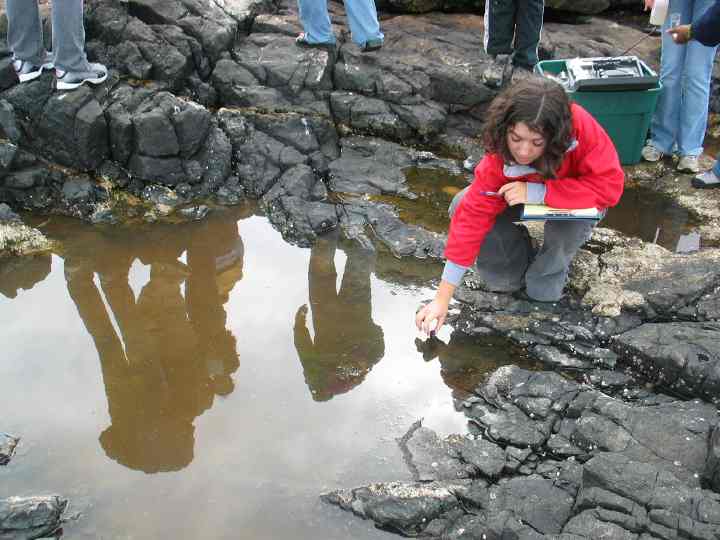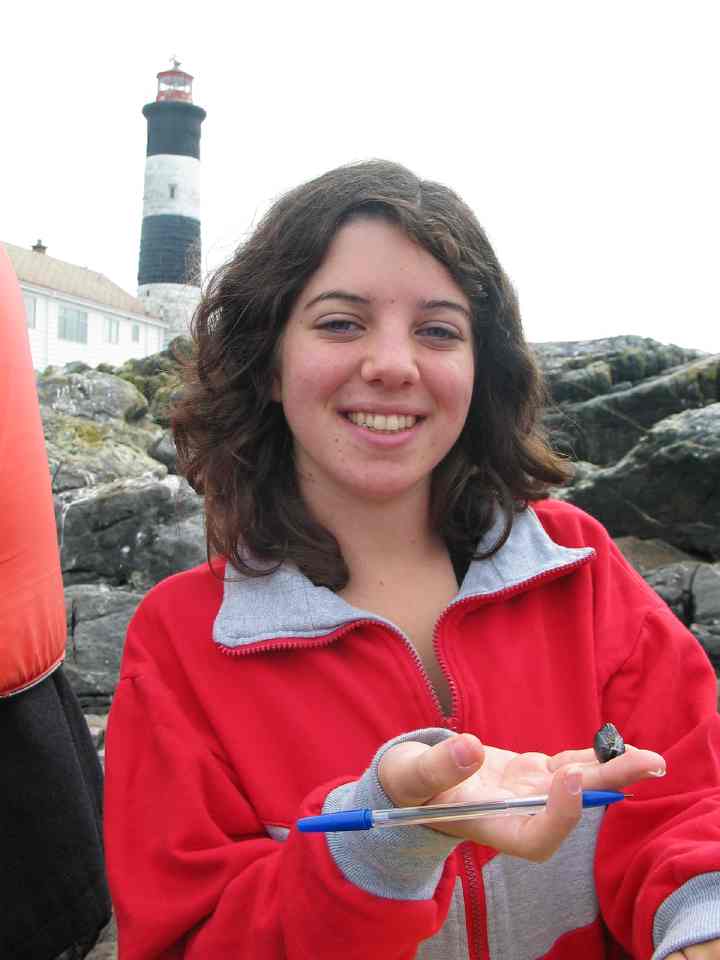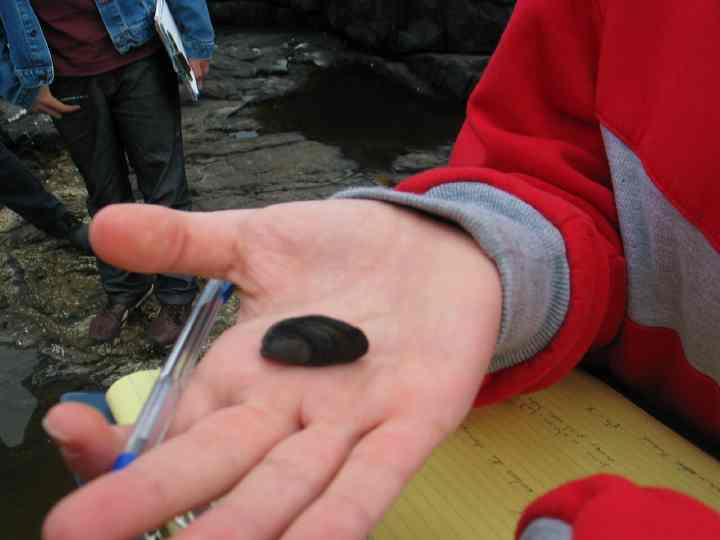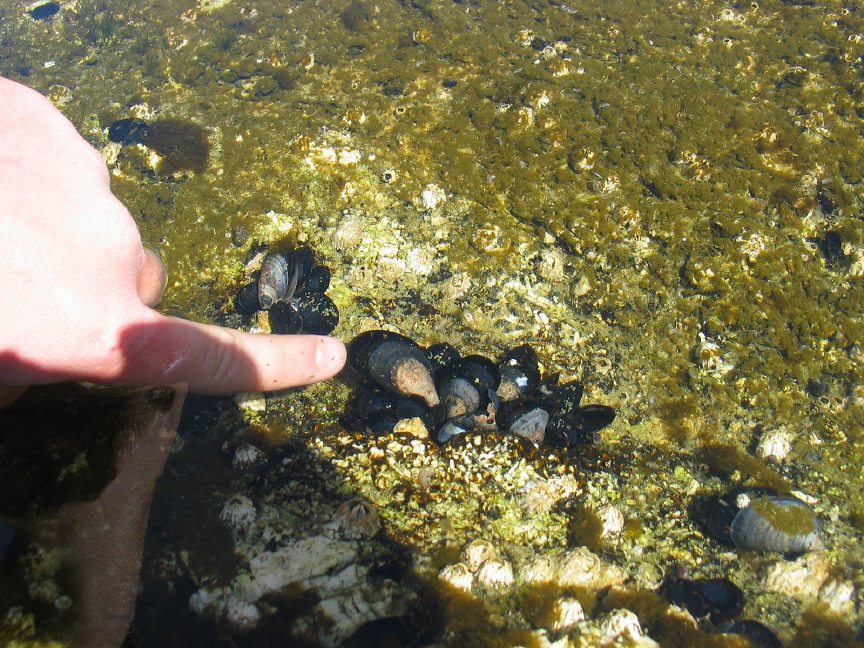Physical Description: Mytilus trossulus has a shiny blue-black to black or brownish thin, long shell. Its exterior is smooth with fine lines. The interior of the shell is dull blue with a darker edge. They can be up to 6 to 10 cm long, and 3 to 5 cm high.
Geographical Range: Arctic to Alaska and south to Central California. (approximate)
Habitat: Mussels attach themselves to rocks pilings & other objects in the mid-intertidal zone of shorelines where water is relatively calm. The elevation at which they can be found is limited by the sea stars in the lower intertidal zone and the risk of desiccation in the upper intertidal zone.
Feeding: Mussels are filter-feeders. They filter many litres of water by moving a set of cilia (long hair-like filaments) over their gills to produce a current-like movement and another set of cilia move the trapped food particles (plankton) into food grooves.
-

-
Here Sara reaches into tidepool 4 to get a Mytilus
-

-
Here Sara displays her Mytilus
-

-
A close-up of the Mytilus trossulus
Reproduction: Many intertidal organisms’ reproductive cycles are adapted to the tide cycles. For Mytilus trossulus, for example, the gonads mature during the spring tides and they spawn after neap tides. The normal cycle of an invertebrate intertidal organism follows the basic pattern of fertilization and larvae. Fertilization can occur within the adult or in the water itself. A larva then develops in the female parent or in the water and it usually doesn’t look very much like the mature adult. The larvae float in the water for a few minutes up to a few months, depending on the species and reproductive cycle. They feed and grow until the end of their planktonic life, when they settle.
Domain Eukarya
Kingdom Animalia
Phylum Mollusca
Class Bivalvia
Subclass Heterodonta
Order Mytiloida
Family Mytilidae
Genus Mytilus
Species trossulus
Common Name: Bay Mussel
Behaviours: Often found in large aggregations.
Adaptations to environment: To resist to mechanical stress from the wave movement, mussels have developed a strong but not permanent attachment to the rocky substrate: their byssal threads. They anchor the mussel to the rock, but can be broken and remade so it can have limited, slow movement. Mytilus trossulus also naturally has a high tolerance to waves. Most intertidal mollusks have hard shells with simple structures that aren’t likely to break under the pressure from the waves. Mussels such as Mytilus edulis, a closely related species close their valves tightly at low-tide to avoid water loss at low tide. Like all intertidal creatures, mussels must expose their fleshy parts to feed, which also exposes them to the threat of desiccation (drying out) and predators. Almost all diurnal rocky intertidal animals feed only when the tide is high and the water is covering them.
In the early 2000’s the Pearson College students in the Environmental System classes would do a lab on mussel mariculture
References: ( referenced 2005)
Shells and Shellfish of the Pacific Northwest, A Field Guide. Rick. M. Harbo, 1997
Biological Bulletin, Vol. 193, No. 2, Oct., 1997 http://www.jstor.org/stable/1542764
Balanced Environmental – Bay Mussel – Mytilus trossulus http://www.balanced.ca/hd/mussel.html
http://www.wallawalla.edu/academics/departments/biology/rosario/inverts/Mollusca/Bivalvia/Mytiloida/Mytilidae/Mytilus_trossulus.html |
 The Race Rocks taxonomy is a collaborative venture originally started with the Biology and Environmental Systems students of Lester Pearson College UWC. It now also has contributions added by Faculty, Staff, Volunteers and Observers on the remote control webcams.
The Race Rocks taxonomy is a collaborative venture originally started with the Biology and Environmental Systems students of Lester Pearson College UWC. It now also has contributions added by Faculty, Staff, Volunteers and Observers on the remote control webcams.




